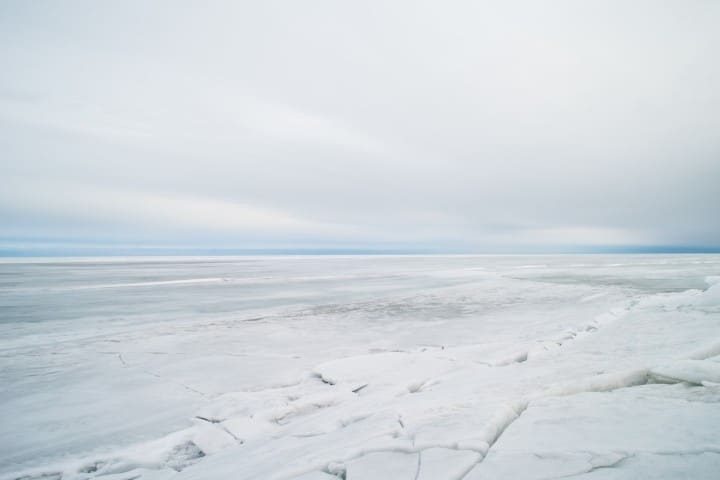
The “Arctic is screaming,” a U.S. government warming-alarmist scientist famously stated in 2010. It turns out this may be true, but what it’s saying is, “I’m freezing!”
In fact, in yet another refutation of the man-caused global-warming (AGW) narrative — and contrary to alarmist predictions — Arctic ice is poised to be its thickest in a generation.
It was in 1975 that Newsweek, reflecting contemporary reportage, ran the story “The Cooling World.” As a young child at the time, I remember the coming-ice-age warnings and, frankly, they were scary. Sure, I loved sledding and snowball fights, but the prospect of living on Snowball Earth wasn’t too appealing.
But sometime later the climate diviners transitioned to doomsayer predictions about global warming. As Electroverse wrote in May:
“Scientists in the US have presented one of the most dramatic forecasts yet for the disappearance of Arctic sea ice,” reported the BBC back in 2007. “Their latest modelling indicates that northern polar waters could be ice-free in summers within just 5-6 years.”
Professor Wieslaw Maslowski from the Department of Oceanography of the US Navy predicted an ice-free Arctic Ocean by the summer of 2013.
Maslowski added that his prediction was on the conservative side, too: “Our projection of 2013 for the removal of ice in summer is not accounting for the last two minima, in 2005 and 2007. So given that fact, you can argue that may be our projection of 2013 is already too conservative.”
Maybe you could have argued that (or anything), but it didn’t come to pass. So the goalposts had to be moved, Fauci-style, and in 2010, “Mark Sereezer [sic], the newly appointed senior scientist at the US government’s Snow and Ice Data Center (NSIDC) in Boulder, Colo. was famously quoted as saying: ‘the Arctic is screaming,’” Electroverse also tells us.
“Geographer Serreze, who now holds the job as NSIDC director, warned that global warming will render the Arctic ice free by the summer of 2030.”
Yes, à la Alexandria Ocasio-Cortez (D-N.Y.), we’re always just 12 years (or so) away from climate-induced End Times.
Except, there’s this: “This week, Arctic sea ice is approaching 10,000,000 km2 — the second highest ice extent of any of the last 15 years,” Electroverse reported just recently. “Furthermore, the years 2008 and 2005 are on course to be eclipsed in the coming days/weeks, as are many from the early-2000s and mid/late-1990s — this means that 2021 will soon claim the title of ‘the highest Arctic sea ice extent of the past two decades’ (since 2001).”
“According to the latest data from the Danish Meteorological Institute (DMI), Arctic sea ice ‘volume’ has been on something of a tear in recent weeks — it is now tracking above all recent years (black line on the below chart), and shows no signs of abating,” the site later wrote (chart is available here).
A hat tip for the above goes to American Thinker’s Thomas Lifson. Writing Wednesday, he also pointed out that authorities in the Russian Far East have decided to dispatch two icebreakers to free ships stuck in the East Siberian Sea. This “comes as severe sea-ice conditions have taken shippers by surprise,” reports The Barents Observer. “There are now about 20 vessels that either are stuck or struggling to make it across the icy waters.”
But what of the other pole and that “melting” Antarctic ice cap? Well, Lifson related that the region just experienced a record cold winter. “As reported last month: ‘Between the months of April and September, the South Pole averaged a temperature of -61.1C (-78F),’” wrote Electroverse. “‘Simply put, this was the region’s coldest 6-month spell ever recorded, and it comfortably usurped the previous coldest ‘coreless winter‘ on record: the -60.6C (-77F) from 1976 (solar minimum of weak cycle 20).’”
Returning to the great, ever-whiter North, Lifson then cited a study released earlier this month. As one Kenneth Richard reported November 15:
Paleoclimate data indicate there was less Arctic sea ice during the pre-industrial period than in modern times, or when CO2 concentrations were 100 ppm lower than today (280 vs. 380 ppm).
Scientists (Diamond et al., 2021) assert that during the 18th and 19th centuries Arctic sea ice extent minimum (September) values averaged 5.54 million km².
… Also, CO2 peaked at only ~280 ppm during the Last Interglacial (LIG), which is approximately the same as the PI CO2 concentration. And yet due to the additional 60-75 W/m² shortwave Arctic forcing during that interglacial relative to today, there was “a consistently ice-free LIG Arctic from early August until early October” from about 130,000 to 115,000 years before present (Diamond et al., 2021).
For more information, see the good work The New American has done on the AGW issue.
So it turns out that the ‘70s global-cooling predictions might’ve been correct — but not according to the mainstream media. In a piece pushed to the top of search engines (surprise, surprise), Time addresses the aforementioned Newsweek story and informs that it ran a version of it decades ago. Defending its current AGW agenda, however, it later writes that “global cooling was much more an invention of the media than it was a real scientific concern”!
Put differently, we’re supposed to believe the media’s current climate narrative because, they say, they were just lying about their previous, contradictory climate narrative. Well, I’m glad they explained that.
Speaking of inventions, Lifson pointed out that the “climate grifters” are wholly uninterested in the data (much as with COVID-19). They’re intent on spending billions forcing everyone into electric cars that will be powered on we know not what. “Windmills and solar panels won’t work, and the greenies hate nuclear power,” noted Lifson.
“It’s all a scam.”
But, hey, if we freeze up in the future, the mainstream media can always trumpet their ‘70s soothsaying. The great thing about being all over the map with your predictions is that it’s like betting on every horse in a race:
You always end up being right about something.


